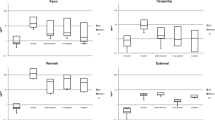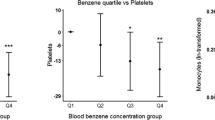Summary
Blood styrene was measured by a gas chromatography-mass spectrometry method in 81 “normal people” and in 76 workers exposed to styrene. In the normal subjects, styrene was also tested in alveolar and environmental air. Styrene was found in nearly all (95%) blood samples. Average styrene levels in the normal subjects were 221 ng/1 in blood (Cb), 3 ng/1 in alveolar air (Ca) and 6 ng/1 in environmental air (Ci). Styrene levels did not differ significantly between smokers and non-smokers, 95% of values being below 512 ng/1 in Cb, 7 ng/1 in Ca and 15 ng/l in Ci. In workers with an average exposure to styrene of 204 μg/l, at the end of the workshift, mean blood styrene concentration was 1211 μg/l. In blood samples collected at the end of the Thursday shift, styrene levels were significantly higher (1590 μg/1) than those found at the end of the Monday shift (1068 μg/l. A similar difference was found in samples taken the morning after exposure (60 and 119 μg/l, respectively). Significant correlations between blood and environmental styrene were found both at the end of the shift and the morning after exposure (r=0.61 and 0.41, respectively). In workers occupationally exposed to styrene, 16 h after the end of the workshift, blood styrene (94 μg/l) was significantly higher than that found in the normal subjects (0.22 μg/l). The half-life of blood styrene was 3.9 h.
Similar content being viewed by others
References
Antoine SR, DeLeon IR, O'Dell-Smith RM (1986) Environmentally significant volatile organic pollutant in human blood. Bull Environ Contam Toxicol 36:364–371
Apostoli P, Brugnone F, Perbellini L, Cocheo V, Bellomo ML, Silvestri R (1983) Occupational styrene exposure: environmental and biological monitoring. Am J Ind Med 4:741–754
Aringer L, Löf A, Elinder CG (1991) The applicability of the measurement of urinary thioethers: a study of humans exposed to styrene during diet standardization. Int Arch Occup Environ Health 63:341–346
Åstrand I, Kilbom Å, Övrum P, Wahlberg I, Vesterberg O (1974) Exposure to styrene. I. Concentration in alveloar air and blood air test and during exercise and metabolism. Work Environ Health 11:69–85
Bartolucci GB, DeRosa E, Gori GP, Chiesura Corona P, Perbellini L, Brugnone F (1985) Biomonitoring of occupational exposure to styrene. Ann Am Conf Ind Hyg 12:275–282
Bartolucci GB, DeRosa E, Gori GP, Corona PC, Perbellini L, Brugnone F (1986) Biomonitoring of occupational exposure to low styrene levels. Appl Ind Hyg 1:125–131
Brugnone F, Perbellini L, Faccini GB, Pasini F, Maranelli G, Romeo L, Gobbi M, Zedde A (1989) Breath and blood levels of benzene, toluene, cumene and styrene in non-occupational exposure. Int Arch Occup Environ Health 61:303–311
Brugnone F, Maranelli G, Romeo L, Giuliari C, Gobbi M, Malesani F, Bassi G, Alexopoulos C (1991) Ubiquitous pollution by n-hexane and reference biological levels in the general population. Int Arch Occup Environ Health 63:157–160
Brugnone F, Perbellini L, Maranelli G, Romeo L, Guglielmi G, Lombardini F (1992) Reference values for blood benzene in the occupationally unexposed general population. Int Arch Occup Environ Health 64:179–184
DeBortoli M, Knoppel H, Pecchio E, Peil A, Rogora L, Schauenburg H, Schlitt H, Vissers H (1985) Measurements of indoor air quality and comparison with ambient air: a study on 15 homes in Northern Italy. Eur 9656, Environmental and quality of life series. Commission of the European Communities, Luxembourg
Guillemin MP, Berode M (1988) Biological monitoring of styrene: a review. Am Ind Hyg Assoc J 49:497–505
Guillemin MP, Bauer D, Martin B, Marazzi A (1982) Human exposure to styrene. IV. Industrial hygiene investigations and biological monitoring in the polyester industry. Int Arch Occup Environ Health 51:139–150
Hornung RW, Reed LD (1990) Estimation of average concentration in the presence of non-detectable values. Appl Occup Environ Hyg 5:46–51
Ikeda M, Koizumi A, Miyasaka M, Watanabe T (1982) Styrene exposure and biological monitoring in FRP boat production plants. Int Arch Occup Environ Health 49:325–339
Kawai T, Yasugi T, Mizunuma K, Horiguchi S, Iguchi H, Uchida Y, Iwami O, Ikeda M (1992) Comparative evaluation of urinalysis and blood analysis as means of detecting exposure to organic solvents at low concentrations. Int Arch Occup Environ Health 64:223–234
Krause C, Mailahn W, Nagel R, Schulz C, Seifert B, Ullrich D (1987) Occurrence of volatile organic compounds in the air of 500 homes in the Federal Republic of Germany. In: Seifert B, Esdorn H, Fischer J, Rüdhen H, Wegner J (eds) Proceedings, 4th International Conference on Indoor Air Quality and Climate, vol 1. Institute for water, soil, and air hygiene, Berlin, August 17–21, pp 102–106
Krotoszynski BK, Bruneau GM, O'Neil HJ (1979) Measurement of chemical inhalation exposure in urban population in the presence of endogenous effluents. J Anal Toxicol 3:225–234
Lauwerys R (1984) Styrene. In: Alessio L, Berlin A, Roi R, Boni M (eds) Biological indicators for the assessment of human exposure to industrial chemicals. Joint Reserach Centre Ispra Establishment, Ispra, Italy, pp 67–81
Löf A, Lundgren E, Nordqvist M (1986) Kinetics of styrene in workers from a plastic industry after controlled exposure: a comparison with subjects not previously exposed. Br J Ind Med 43:537–543
Maranelli G, Perbellini L, DeRosa E, Bartolucci GB, Cellini M, Sessa G, Brugnone F (1992) Stirenemia a 16 ore dalla fine del turno di lavoro (in Italian). In: Catelani EG, Lastrucci L, Saccardi E, Sbrana C (eds) Atti del Convegno Nazionale: Rischi e Bonifiche nella Costruzione di Imbarcazioni in Vetroresina. Pezzini Editore, Viareggio (Lucca), pp 67–72
Perbellini L, Pasini F, Faccini GB, Danzi B, Gobbi M, Zedde A, Cirillo P, Brugnone F (1988b) Determinazione di solventi ad use industriale nel sangue, nell'aria alveolare a nell'urina di un gruppo di donatori di sangue (in Italian). Med Lav 79:460–467
Perbellini L, Romeo L, Maranelli G, Zardini G, Alexopoulos C, Brugnone F (1990) Biological monitoring of fluctuating occupational exposure to styrene. Med Lav 81:382–389
Ramsey JC, Young JD, Karbowski RJ, Chenoweth MB, MacCarty LP, Braun WH (1980) Pharmacokinetics of inhaled styrene in human volunteers. Toxicol Appl Pharmacol 53:54–63
Sato A, Nakajima T (1979) Partition coefficients of some aromatic hydrocarbons and ketones in water, blood and oil. Br J Ind Med 36:231–234
Tossavainen A (1978) Styrene use and occupational exposure in the plastics industry. Scand J Work Environ Health 4 (Suppl 2):7–13
Wallace LA, Pellizzari ED, Hartwell TD, Sparacino CM, Sheldon LS, Zelon H (1985) Personal exposure, indoor-out-door relationships, and breath levels of toxic air pollutants measured for 355 persons in New Jersey. Atmos Environ 19:1651–1661
Wigaeus E, Löf A, Bjurström R, Nordqvist B (1983) Exposure to styrene: uptake, distribution, metabolism elimination in man. Scand J Work Environ Health 9:479–488
Wolff MS (1976) Evidence for existence in human tissues of monomers for palstics and rubber manufacture. Environ Health Perspect 17:183–187
World Health Organization (1983) Environmental health criteria 26: styrene. World Health Organization, Geneva]
Author information
Authors and Affiliations
Rights and permissions
About this article
Cite this article
Brugnone, F., Perbellini, L., Wang, G.Z. et al. Blood styrene concentrations in a “normal” population and in exposed workers 16 hours after the end of the workshift. Int. Arch Occup Environ Heath 65, 125–130 (1993). https://doi.org/10.1007/BF00405731
Received:
Accepted:
Issue Date:
DOI: https://doi.org/10.1007/BF00405731




